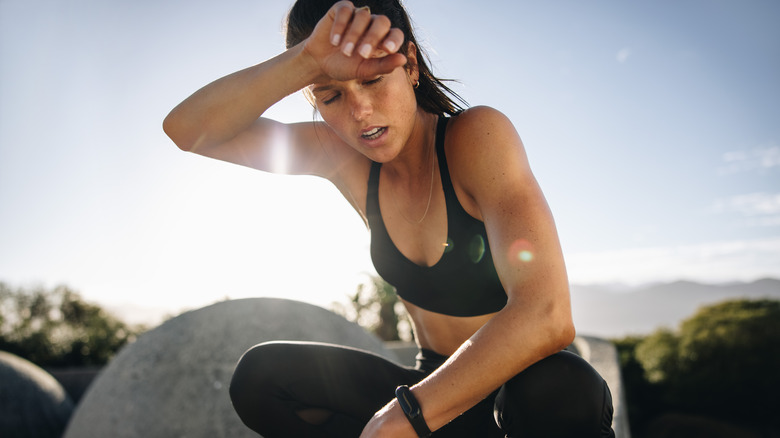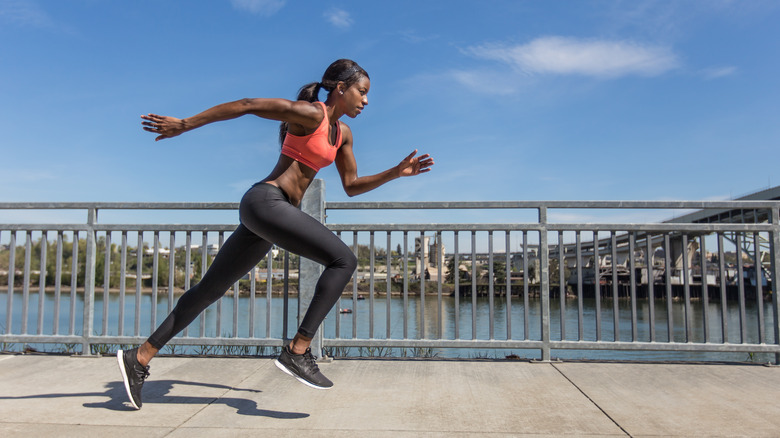Is Your HIIT Workout Actually Causing You More Stress?
High-intensity interval training, or HIIT, has been a popular component of fitness centers all over the country, including Orangetheory Fitness, Crunch Fitness, and F45. This type of training offers physical and mental benefits, so many fitness studios incorporate it into their workout templates. Many fitness experts swear by the benefits, but many also acknowledge the potential risks to the body and the mind if you overdo it.
As the phrase implies, HIIT involves a brief period (usually under a minute) of a particular exercise at a high-intensity level, such as sprinting, immediately followed by a period of rest. The physical risks are apparent to most people who have ever performed a HIIT workout since they're visible, but the mental jeopardies are harder to detect.
Perhaps you participate in HIIT regularly for health benefits, like stress relief, but did you know this training can cause your body more stress? If you're doing too much HIIT or not allowing yourself enough recovery — or both — you could be doing more damage than good, thanks to a hormone called cortisol.
What is the science behind HIIT and cortisol?
When you're sprinting at 15 mph, pedaling to the max, or doing as many jumping jacks as you can, a lot of things are happening in your body. Your muscles are moving quickly, your heart rate is accelerating, and your cortisol levels are rising, as Healthline explains. Cortisol is a hormone that the adrenal glands release to help the body deal with the stress of high-intensity exercise, which is why it's called the stress hormone.
Cortisol levels naturally fluctuate throughout the day, even if you do no exercise at all. However, according to the 2021 study published in the Scandinavian Journal of Medicine & Science in Sports, your cortisol level can increase dramatically after a single HIIT workout. Plus, it can take up to two hours to return to normal. Cortisol, in general, can be beneficial to the body, but at a high level for an extended amount of time, it can be dangerous, notes another 2021 study showcased in the Journal of Clinical Medicine.
How exactly can HIIT cause stress?
Remember, HIIT offers a wide range of benefits, and if you do it correctly and safely, you shouldn't have to worry about it causing you stress. However, there is a correlation between excessive HIIT and a lack of sufficient recovery and stress. Recovery after any exercise is important but especially critical during and after a HIIT activity. Always take short rest periods after each high-intensity interval and a longer rest period after the workout ends, before the next begins.
Without sufficient, appropriate recovery, you could put yourself at risk for a cortisol imbalance, which typically coincides with overtraining syndrome or OTS. The mental symptoms of OTS and a high cortisol level include moodiness, anxiety, and depression, all linked to stress. It's possible to experience these symptoms, not just immediately after a HIIT workout but also days later.
Having brief moments of high cortisol levels is beneficial in emergencies, such as when you're running from danger or chasing a toddler who is running toward danger. You may know this high-alert, fight-or-flight response as an adrenaline rush. Adrenaline is the hormone the body releases before it discharges cortisol and involves an accelerated heart rate. Still, you probably don't want this surge in your body during the calm moments of your day.
How to do HIIT safely to prevent stress and other risks
Although HIIT can be risky, that doesn't mean it should be avoided, especially considering all the benefits. You just need to be smart about when, how, and how often you do it. Physiology experts recommend 60-second spurts of high intensity, followed by 60 seconds of recovery, for the best results.
Another thing to keep in mind is that not all HIIT has to involve trying to reach your absolute best speed, distance, watts, or weight. Not every session needs to be an all-out effort, especially if you're new to HIIT. Instead, you can alternate between running at 5 mph and sprinting at 10 mph before you rest. You can still reap the benefits since your heart rate will fluctuate with each interval.
It's also important to prepare and listen to your body. Always stretch before and after your workout. And regardless of your activity, if you start feeling any pain in your chest or other parts of your body, stop immediately. Know your limits and be smart about responding to signs of trouble.
How to properly and effectively recover after HIIT
Because HIIT can tax the body, allowing yourself enough time to rest and recover properly is essential. This can help prevent injury, stress, and other negative side effects. The best recommendation is to transition to an active recovery before you completely stop moving after your HIIT workout. So if your session consists of sprinting and power walking at 4 mph, you can decrease your active recovery to 3 mph. Then, gradually decrease the speed until you stop completely.
Other important elements of rest and recovery include stretching, rehydrating, and sleeping. For the stretch, hold various static stretches for about 30 seconds each, and at some point, whether it's during your active recovery or stretching, make sure to rehydrate with water or an electrolyte beverage. And last but not least, ensure you get in at least hours of Z's after a HIIT workout so your muscles can repair themselves.
How often should you incorporate a HIIT workout into your weekly exercise regime? Completing no more than two 30 to 45-minute HIIT exercise sessions per week is vital. Remember to always listen to your body when determining how to separate those two sessions. If you need two, three, or more days to recover before jumping into the next HIIT exercise — or any workout — take that time and use it wisely.




